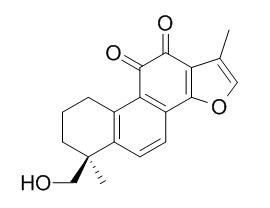Tanshinone IIB
Co-treatment with Tanshinone IIB (TSB) significantly inhibits the DNA laddering, cytotoxicity and apoptosis of rat cortical neurons induced by staurosporine in a concentration-dependent manner; TSB also suppresses the elevated Bax protein and decreased bcl-2 and caspase-3 proteins induced by staurosporine in rat cortical neurons; TSB is effective in reducing stroke-induced brain damage and may represent a novel drug candidate for further development.
TSB significantly inhibits the uptake of digoxin and vinblastine in membrane vesicles containing PgP or MRP1, moderately stimulates PgP ATPase activity, suggesting TSB is a substrate for PgP and MRP1 and that drug resistance to TSB therapy and drug interactions may occur through PgP and MRP1 modulation.
Inquire / Order:
manager@chemfaces.com
Technical Inquiries:
service@chemfaces.com
Tel:
+86-27-84237783
Fax:
+86-27-84254680
Address:
1 Building, No. 83, CheCheng Rd., Wuhan Economic and Technological Development Zone, Wuhan, Hubei 430056, PRC
Providing storage is as stated on the product vial and the vial is kept tightly sealed, the product can be stored for up to
24 months(2-8C).
Wherever possible, you should prepare and use solutions on the same day. However, if you need to make up stock solutions in advance, we recommend that you store the solution as aliquots in tightly sealed vials at -20C. Generally, these will be useable for up to two weeks. Before use, and prior to opening the vial we recommend that you allow your product to equilibrate to room temperature for at least 1 hour.
Need more advice on solubility, usage and handling? Please email to: service@chemfaces.com
The packaging of the product may have turned upside down during transportation, resulting in the natural compounds adhering to the neck or cap of the vial. take the vial out of its packaging and gently shake to let the compounds fall to the bottom of the vial. for liquid products, centrifuge at 200-500 RPM to gather the liquid at the bottom of the vial. try to avoid loss or contamination during handling.
Srinakharinwirot University2023, 2669.
Foods.2023, 12(19):3647.
Planta Med.2023, 2192-2281
Free Radic Biol Med.2021, 166:104-115.
Processes2021, 9(11),2065.
Biomed Chromatogr.2020, e5021.
J Ethnopharmacol.2020, 249:112396
Pharmaceuticals (Basel).2021, 14(8):742.
J Nat Med.2020, 74(3):550-560.
Int J Mol Sci. 2014, 15(5):8443-57
Related and Featured Products
Drug Metab Lett. 2007 Aug;1(3):205-17.
Involvement of P-glycoprotein and multidrug resistance associated protein 1 in the transport of tanshinone IIB, a primary active diterpenoid quinone from the roots of Salvia miltiorrhiza, across the blood-brain barrier.[Pubmed:
19356045]
Tanshinone IIB (TSB) is a major constituent of Salvia miltiorrhiza, which is widely used in treatment of cardiovascular and central nervous system (CNS) diseases such as coronary heart disease and stroke. This study aimed to investigate the role of various drug transporters in the brain penetration of Tanshinone IIB using several in vitro and in vivo mouse and rat models.
METHODS AND RESULTS:
The uptake and efflux of Tanshinone IIB in rat primary microvascular endothelial cells (RBMVECs) were ATP-dependent and significantly altered in the presence of a P-glycoprotein (P-gp) or multidrug resistance associated protein (Mrp1/2) inhibitor. A polarized transport of Tanshinone IIB was found in RBMVEC monolayers with facilitated efflux from the abluminal to luminal side. Addition of a P-gp inhibitor (e.g. verapamil) in both abluminal and luminal sides attenuated the polarized transport. In an in situ rat brain perfusion model, Tanshinone IIB crossed the blood-brain barrier (BBB) and blood-cerebrospinal fluid barrier at a greater rate than that for sucrose, and the brain penetration was increased in the presence of a P-gp or Mrp1/2 inhibitor. The brain levels of Tanshinone IIB were only about 30% of that in the plasma and it could be increased to up to 72% of plasma levels when verapamil, quinidine, or probenecid was co-administered in rats. The entry of Tanshinone IIB to CNS increased by 67-97% in rats subjected to middle cerebral artery occlusion or treatment with the neurotoxin, quinolinic acid, compared to normal rats. Furthermore, The brain levels of Tanshinone IIB in mdr1a(-/-) and mrp1(-/-) mice were 28- to 2.6-fold higher than those in the wild-type mice.
CONCLUSIONS:
Tanshinone IIB has limited brain penetration through the BBB due to the contribution of P-gp and to a lesser extent of Mrp1 in rodents. Further studies are needed to confirm whether these corresponding transporters in humans are involved in limiting the penetration of Tanshinone IIB across the BBB and the clinical relevance.
Phytother Res. 2008 Jun;22(6):846-50.
Tanshinone IIB, a primary active constituent from Salvia miltiorrhiza, exerts neuroprotective effect via inhibition of neuronal apoptosis in vitro.[Pubmed:
18389485 ]
Tanshinone IIB (TSB) is a major active constituent of the roots of Salvia miltiorrhiza (Danshen) widely used in the treatment of stroke and coronary heart disease in Asian countries.
METHODS AND RESULTS:
This study investigated the in vitro neuroprotective effects of TSB and the underlying mechanism. Co-treatment with TSB significantly inhibited the cytotoxicity and apoptosis of rat cortical neurons induced by staurosporine in a concentration-dependent manner. Consistently, TSB significantly reduced the DNA laddering caused by staurosporine in a concentration-dependent manner. TSB also suppressed the elevated Bax protein and decreased bcl-2 and caspase-3 proteins induced by staurosporine in rat cortical neurons.
CONCLUSIONS:
These findings indicated that TSB had a neuroprotective effect via inhibition of apoptosis. Further studies are warranted to investigate the role of other apoptosis-related signaling proteins and reperfusion-related mechanisms in the protective effect of TSB on neurons.



